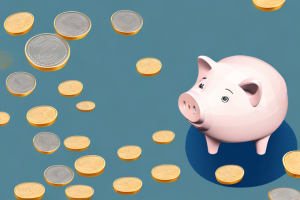Saving money is an essential component of building long-term financial security. By consistently setting aside $500 each month, you can make significant progress towards your financial goals. In this article, we will explore the power of consistent saving, the importance of setting financial goals, and how to calculate your savings potential.
The Power of Consistent Saving
Consistency is key when it comes to saving money. By saving $500 every month, you establish a habit that can lead to financial stability and potential growth. Consistent saving allows you to take advantage of compound interest and maximize the growth of your savings over time.
Moreover, consistent saving helps you develop financial discipline and the ability to resist unnecessary spending. It allows you to prioritize your future financial well-being and align your spending habits accordingly.
The Importance of Setting Financial Goals
Setting clear financial goals is essential for managing your savings effectively. When you save $500 a month, having a clear objective in mind can help you stay motivated and focused on your long-term financial aspirations.
Financial goals can vary from person to person, but they often include saving for retirement, buying a house, starting a business, or creating an emergency fund. By identifying your goals and regularly reassessing them, you can track your progress and make adjustments along the way.
Calculating Your Savings Potential
Knowing how much you can accumulate by saving $500 each month is important for setting realistic expectations and staying motivated. To calculate your savings potential, you need to consider the interest rates offered by various saving options.
For instance, placing your savings in a high-yield savings account may yield a certain interest rate. By using a compound interest calculator, you can determine the growth of your savings over time and visualize the impact of compounding. Additionally, exploring other saving options like certificates of deposit (CDs) or investment accounts can also enhance your savings potential.
Creating a Monthly Budget: A Step-by-Step Guide
A solid budget is the foundation for successful saving. By creating a detailed monthly budget, you can identify areas where you can cut expenses and increase your savings.
Start by tracking your expenses for a few months to get a clear picture of your spending habits. Categorize your expenses and identify areas where you can make adjustments. This could include reducing discretionary spending, negotiating bills, or finding more cost-effective alternatives. By reallocating the money saved from cutting expenses, you can easily set aside $500 per month.
Remember, budgeting is an ongoing process, so make sure to regularly review and adjust your budget as your financial situation changes.
Tips for Cutting Expenses and Increasing Savings
There are various strategies you can implement to cut expenses and boost your savings potential. First, scrutinize your monthly bills and consider negotiating with service providers to obtain better rates. This could include your cable or internet provider, insurance companies, or even your cell phone plan.
Additionally, aim to reduce discretionary spending by evaluating your lifestyle choices. Cook at home instead of dining out, explore free entertainment options, and consider carpooling or using public transportation to save on transportation expenses. Small changes in your daily habits can result in substantial savings over time.
To further increase your savings, look for opportunities to earn extra income. This could involve taking on a part-time job, freelancing, or monetizing your skills and hobbies. By diversifying your income streams, you can expedite your savings goal and potentially increase your overall financial security.
Strategies for Staying Motivated to Save
Maintaining motivation throughout your savings journey is crucial. While initially saving $500 a month may seem achievable, it’s normal to encounter challenges and temptations along the way. Here are some strategies to help you stay motivated:
- Visualize your financial goals: Create a vision board or use visualization techniques to remind yourself of what you’re working towards.
- Celebrate milestones: Reward yourself when you reach certain saving milestones to maintain a sense of accomplishment and motivation.
- Join a savings challenge or support group: Engaging with others who have similar goals can provide support, accountability, and helpful advice.
- Track your progress: Use budgeting apps or savings trackers to monitor your progress regularly. Seeing your savings grow can be highly motivating.
How Compound Interest Can Boost Your Savings
Compound interest is a powerful tool that can significantly amplify your savings. When you save $500 a month consistently, compound interest allows your money to generate additional earnings on top of the initial amount invested.
Over the course of a year, the interest earned on your savings will compound, meaning you earn interest not only on your initial $500 monthly deposits but also on the interest already earned. This compounding effect accelerates the growth of your savings and helps you reach your financial goals faster.
It’s important to research and compare savings accounts or investment options that offer competitive interest rates to maximize the benefits of compound interest.
Exploring Different Saving Options: Bank Accounts, CDs, and Investment Accounts
While traditional savings accounts are a common choice for depositing your monthly savings, exploring other saving options can potentially increase your returns.
Consider certificates of deposit (CDs), which lock in your money for a predetermined period at a fixed interest rate. CDs often offer higher interest rates than regular savings accounts, making them a viable option if you have a longer-term savings goal.
If you are comfortable with a certain level of risk, investment accounts like mutual funds or exchange-traded funds (ETFs) can provide higher potential returns over the long-term. However, it is important to conduct thorough research and consider speaking with a financial advisor before entering the investment market.
Evaluating the Risk vs Reward of Different Saving Strategies
Every saving strategy comes with its own level of risk and potential reward. Evaluating these factors is crucial to aligning your savings strategy with your risk tolerance and financial goals.
While savings accounts may offer lower interest rates, they bring the advantage of liquidity and low risk. CDs offer higher interest rates but restrict access to your funds for a predetermined period. Investment accounts have the highest potential for growth but carry market risks and require a longer investment horizon.
Considering your financial goals, time horizon, and risk tolerance will help you choose the saving strategy that best suits your needs.
Tracking Your Progress: Using Apps and Tools to Monitor Your Savings
Tracking your savings progress is essential for staying on top of your financial goals. Numerous apps and online tools are available to assist you in managing and monitoring your savings.
Some popular budgeting and savings apps include Mint, Personal Capital, and YNAB (You Need a Budget). These platforms allow you to link your bank accounts, categorize your expenses, and set savings goals. They provide you with a holistic overview of your finances, making it easier to track your progress and identify areas for improvement.
Additionally, many banking institutions offer online banking tools that enable you to track your savings growth, set up automatic transfers, and receive real-time updates on your account balances.
Planning for Unexpected Expenses: The Importance of an Emergency Fund
Building an emergency fund is a crucial element of any comprehensive savings plan. It acts as a safety net in case of unexpected expenses or financial emergencies.
Aim to set aside at least three to six months’ worth of living expenses in a separate account. This fund will provide you with financial security and peace of mind, ensuring that unforeseen circumstances do not derail your progress towards your long-term goals.
When saving $500 monthly, allocating a portion towards your emergency fund is essential to safeguard against unexpected expenses.
Maximizing Your Savings with Tax-Advantaged Accounts like IRAs and 401(k)s
When saving for retirement or long-term financial security, utilizing tax-advantaged accounts can maximize your savings potential.
Individual Retirement Accounts (IRAs) and employer-sponsored retirement plans like 401(k)s provide tax benefits that help your savings grow faster. Contributions to these accounts are often tax-deductible, meaning you can reduce your taxable income for the year. Additionally, the earnings within these accounts grow tax-free or tax-deferred until withdrawal.
By contributing a portion of your monthly $500 savings to these retirement accounts, you can build a significant nest egg while enjoying tax advantages.
Navigating Market Volatility: How to Protect Your Investments and Savings
During your savings journey, you may encounter market volatility and fluctuations. While it is important to stay focused on your long-term goals, there are steps you can take to protect your investments and savings.
Diversification is a fundamental strategy to mitigate risk. Spreading your investments across various asset classes, such as stocks, bonds, and real estate, can help reduce the impact of market fluctuations on your overall portfolio.
Additionally, staying informed about market trends and economic indicators can help you make more informed decisions. Regularly reviewing your investment portfolio and rebalancing it to align with your risk tolerance and objectives is also advisable.
Celebrating Milestones: Reflecting on Your Yearly Saving Journey
As you consistently save $500 a month for a year, it is important to celebrate milestones and reflect on your progress. Take the time to appreciate how far you have come and acknowledge your dedication and discipline.
Reflect on the positive changes that saving has brought to your life, such as increased financial security, reduced stress, and improved peace of mind. Consider rewarding yourself for reaching significant milestones, whether it’s treating yourself to a small indulgence or taking time to assess your progress towards larger financial goals.
The Impact of Saving $500 a Month on Long-Term Financial Security
Saving $500 a month may not seem like a significant amount initially, but its impact on long-term financial security cannot be overstated. Consistently setting aside this monthly sum can lead to tremendous growth over time.
By taking advantage of compound interest and diligently saving for years, you can accumulate a substantial nest egg. This savings can provide you with financial flexibility, a comfortable retirement, and the ability to weather unexpected challenges.
Remember, the key is consistency and a long-term perspective. Every dollar saved brings you closer to a more secure financial future.
Leveraging Saving Habits to Achieve Other Financial Goals, like Buying a Home or Starting a Business
Successfully saving $500 a month for a year not only contributes to your general financial well-being but can also enable you to achieve other specific financial goals.
For example, if your goal is to own a home, your consistent savings can be used towards a down payment. By establishing a savings habit and building a sizable savings account, lenders may see you as a more reliable borrower, potentially qualifying you for better mortgage rates.
Similarly, if you aspire to start a business, your savings can serve as seed capital or a contingency fund during the early stages. By leveraging your savings habits and utilizing your financial discipline, you can take meaningful steps towards making your entrepreneurial vision a reality.
Lessons Learned: Real-Life Stories from Individuals who Successfully Saved $500 a Month for a Year
To further inspire and motivate you on your savings journey, it can be helpful to hear real-life stories from individuals who have successfully saved $500 a month for a year. These stories showcase the power of consistency, discipline, and determination.
From learning how to manage unexpected expenses to making conscious lifestyle adjustments, the experiences of others can provide invaluable insights and strategies for achieving your own financial goals.
Remember, everyone’s financial journey is unique, so take inspiration from these stories while creating a plan that aligns with your specific circumstances.
In conclusion, if you save $500 a month for a year, the impact on your financial well-being can be significant. Consistent saving, clear financial goals, and smart strategies can help you build a sizable savings account, mitigate risks, and achieve long-term financial security. Remember to leverage the power of compound interest, track your progress, and stay motivated throughout your savings journey. By making saving a priority, you are taking a major step towards a secure financial future.



